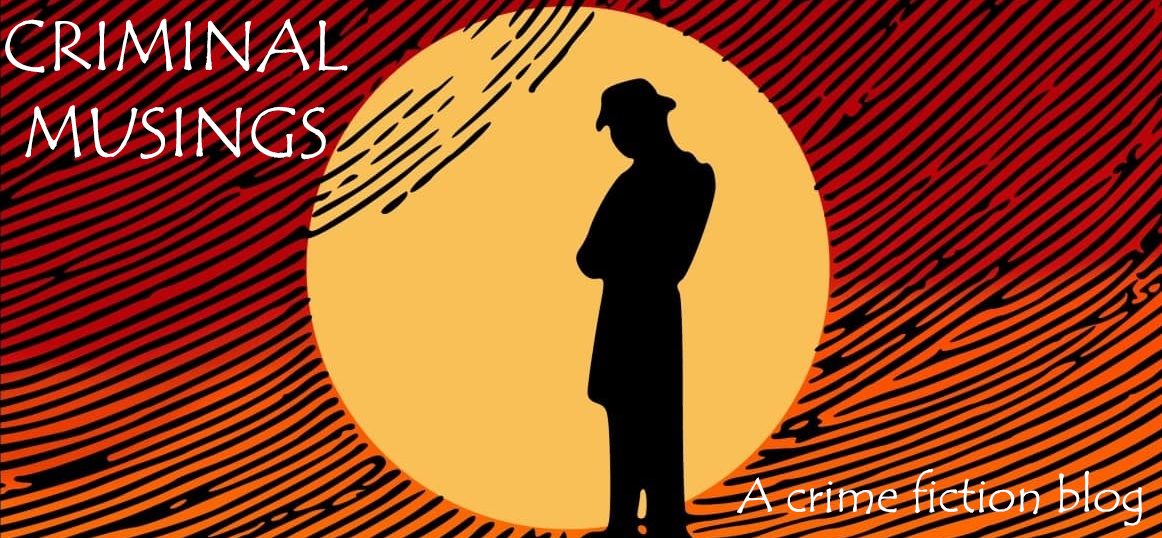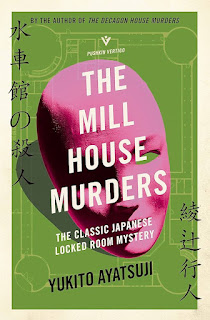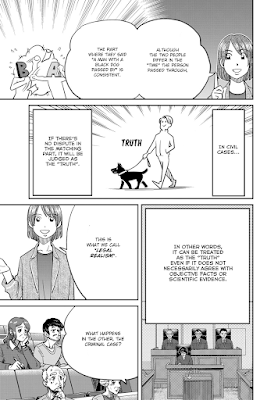I had initially planned to discuss Suishakan no Satsujin (1988; translated and published as The Mill House Murders by Pushkin Vertigo in 2023), the second novel in Yukito Ayatsuji's Yakata series, alongside The Decagon House Murders, but my fanboying of the latter turned too long for my taste. Hence, the decision to write about The Mill House Murders in a separate post.
The way things ended in The Decagon House Murders, it was hard to envision a sequel to the work. The Mill House Murders, while not exactly a sequel in the truest sense of the word, serves as a great example of how even a minor, almost inconsequential, detail can serve as the basis of a series in continuity — in my very limited reading of the Yakata series (only two works in English translation so far), the two connecting threads would be that they share a common detective and that they are all set in mansions and buildings constructed by the eccentric architect, Seiji Nakamura, introduced and killed off in the first novel itself. The result seems to be a series whose works can be enjoyed both as standalone entries (featuring the odd tribute to previous masters of the craft) as well as part of a loosely-connected chronological set. And on that note of continuity, The Mill House Murders is a work that is fascinatingly similar and dissimilar to The Decagon House Murders, in ways both good and bad.
My first impression of the second entry in the Yakata series was that the sprightly, breezy nature of the first novel had been replaced with a heavy, brooding atmosphere. While The Decagon House Murders had a lightness of touch to it, replicating the essence of an Ellery-Queen puzzle plot, The Mill House Murders is heavy-handed in its execution, doffing its hat instead to the works of another master, John Dickson Carr. However, the main trickery employed here makes it another Christie tribute novel, in my opinion, even though it may not be as evident as seen in The Decagon House Murders.
The Mill House Murders is narrated from the perspective of one of the characters, a resident of the eponymous Mill House (named so after the mill wheels generating power), another strange creation of Seiji Nakamura. The narrator is introduced as the current owner of the Mill House — and is the son of a 'visionary' painter who drew a number of remarkable surrealist scenes and landscapes before dying. Every year, he hosts a diverse group of guests — a disciple of the deceased visionary painter, an art dealer, a professor of art history, a director of a surgical hospital, and a few others — all of whom gather to marvel at the painter's works and to chance their luck at buying one of the masterpieces (particularly The Phantom Cluster, a painting that no one has seen). However, tragedy struck when the group met a year prior to the events of the novel — "a woman fallen from the tower", "a painting disappeared", "a man vanished under seemingly impossible circumstances", and "another man ... killed, cut up in pieces and burnt in the incinerator". The novel does a great job, straight-up mentioning the past mysteries in the prologue itself. And, thrown into this mix is the series detective, Kiyoshi Shimada, who arrives to the mansion in the present day, to solve the mystery of his friend's impossible disappearance the year previous.
But then, it starts to suffer from a few design issues. Unlike The Decagon House Murders, the division of the narrative in The Mill House Murders is mostly time-based as the movements of the characters are limited to the confines of the mansion and its tower. What this essentially means is that most of the action in the novel consists of a cast of mostly familiar faces roaming over the same grounds in different combinations and circumstances. While this is not a bad thing by itself, the novel goes out of its way in the early stages to demonstrate how eerily the events of the present day and the previous year parallel each other. Consider, for example, the two opening sections of the first two chapters:
I woke as I usually do. The amber curtains were drawn over the windows facing the courtyard to the east, but the bright morning sun shone right through them into the room. It was quiet outside, but if I listened carefully, I could just make out the faint chirping of the mountain birds, as well as the distant sound of flowing water. I could also hear the heavy rumble of the mill wheels, always revolving by the western side of this house. It was a peaceful morning.
We’d had good weather ever since September came along, but the news last night had reported an approaching typhoon. The forecast said it would start raining in the Chūgoku region this afternoon. This morning was thus, truly, the calm before the storm.
I slowly sat up in the spacious bed. The clock on the wall showed half past eight. The same time I always woke up.
Leaning back against the headboard, I reached for the nightstand with my right hand, picked up my old briar pipe and packed it with tobacco. Soon a mellow scent filled the room, accompanied by cream-coloured smoke.
“A typhoon, eh?” I mumbled out loud to myself. My voice was unnaturally hoarse.
I had to think back to exactly one year ago, 28th September. The morning of that fateful day had been the same as today. There’d been reports of an approaching typhoon then too. And it arrived just as forecast.
One year… A whole year had passed since that blood-soaked night.
I became lost in thought, my hand swaying with the pipe. The tentacles of my mind crept towards the events of that night one year ago, to everything that occurred the following day, and even to what happened afterwards.
I stole a glance at the door in the corner of the room, the bronze doorknob and dark mahogany panelling. That door, which led to the study, would never be opened again…
My lean body suddenly shuddered. An indescribable, inescapable shiver welled up from deep within and ran through my whole being.
It was a quarter to nine now. The phone on my nightstand would ring soon, softly signalling the start of another day.
“Good morning, sir.”
The familiar voice on the other end of the line sounded calm. It was the butler, Kuramoto Shōji.
“I will be bringing you your breakfast right away.”
“Thanks.”
I placed my pipe on its stand and started getting dressed. I took my pyjamas off, put on a shirt and trousers, and a dressing gown on top. When I had managed to do all of this, I put the cotton gloves on both my hands. And finally, it was time to put on my face.
My mask.
That mask was a symbol of my whole life at this time, a symbol of everything that Fujinuma Kiichi now was.
A mask. Indeed, I had no face. I wore that mask every single day to hide my accursed features. The white mask was now the real face of the master of the house. The rubber clung to my skin. A cold death mask worn by a living man.
and
He woke as he usually did. The amber curtains were drawn over the windows facing the courtyard to the east, but the bright morning sun shone right through them into the room. It was quiet outside, but if he listened carefully, he could just make out the faint chirping of the mountain birds, as well as the distant sound of flowing water. He could also hear the heavy rumble of the mill wheels, always revolving by the western side of the house. It was a peaceful morning.
The news last night had reported an approaching typhoon. The forecast said it would start raining in the Chūgoku region on the afternoon of the 28th.
He slowly sat up in the spacious bed. The clock on the wall showed half past eight. The same time he always woke up.
Leaning back against the headboard, he reached for the nightstand with his right hand, picked up his old briar pipe and packed it with tobacco. Soon a mellow scent filled the room, accompanied by cream-coloured smoke.
Three days ago he’d caught a cold and ran a fever, but he’d recovered now. He could savour the scent of tobacco again.
He slowly closed his eyes as he puffed his pipe.
28th September. Ōishi Genzō, Mori Shigehiko, Mitamura Noriyuki and Furukawa Tsunehito. Today was the day the four of them would visit him in the afternoon, just as they had done in previous years.
Their annual visit was not a joyous occasion for him, living as he did in this house deep in the mountains, hiding from the outside world. He honestly felt their visit was a great annoyance.
Yet he was also in denial about his feelings. He could easily tell them not to come if he genuinely did not want them to. But his inability to turn them away all these years was perhaps partially due to guilt.
He kept his eyes closed as a low sigh escaped his cracked lips.
Anyway, they’re coming today. It’d all been decided, so nothing could be changed now.
He had no intention of making a detailed analysis of his own contradictory thoughts. The visit plagued him, but he also welcomed it. That was all there was to it.
It was a quarter to nine now. The phone on his nightstand would ring soon, softly signifying the start of another day.
“Good morning, sir.”
The familiar voice on the other end of the line sounded calm. It was the butler, Kuramoto Shōji.
“How are you feeling, sir?”
“Better now, thanks.”
“I can bring your breakfast immediately if you wish.”
“I’ll come down myself.”
He placed his pipe on its stand and started getting dressed. He took his pyjamas off, put on a shirt and trousers, and a dressing gown on top. When he had managed to do all of this, he put the cotton gloves on both his hands. And finally, it was time to put on his face.
His mask.
The mask could be considered the symbol of the last twelve years of his life, a symbol of everything that Fujinuma Kiichi was.
Indeed, he had no face. He wore this mask every single day to hide his accursed features. This white mask bearing the features of Fujinuma Kiichi, the master of this house. The rubber clung to his skin. A cold death mask worn by a living man.
There are important reasons, both stylistic and plot-based, behind such a narration, which are revealed towards the end of the novel. But, I am not sure that this style of closely mirroring prose over long stretches and/or entire chapters is necessarily in the best interests of the book. If nothing else, it invites the allegation that the narration is lazy, long-drawn and stretched—an allegation that is justifiable for the first half of the novel. Even more infuriating is the fact that the repetition spills over into the conversations between the characters during this stretch, with the result that, time and again, readers are forcibly reminded of the multiple events that occurred in many of the characters' pasts, to the point of memorising them. Even though a sense of unease (that things are not as they seem) persists—and despite Shimada's constant needling—any fair, outright indication of the deception behind the events of the past is not explicitly revealed till a much later period in the novel.
The experience of reading the first half/three-fourths of the novel is akin to that of playing a challenging, laborious dungeon-crawler game where one knows the entry- and exit-points of the maze and, seemingly, the major boss to be overcome. However, they still need to explore the same dungeon time-and-time again to unravel different secrets (spaces, quests or resources) that reveal themselves only during a replay and which have a bearing on the game and its completion, and can potentially change the nature of the dungeon-space itself. In the case of The Mill House Murders, readers are likely to retread the same incidents, stories from the past and developments in the present time from the mostly similar perspectives of multiple characters—and each time, they are likely to have to refer to the previous mention of said incident to spot the critical difference/change in viewpoint. Besides not making for a smooth, fluid read, this is, indeed, an excruciating exercise in patience—not unlike taking on and staring at an extremely difficult spot-the-difference challenge where the differences are microscopic to a visible eye.
It does not help that a superior treatment of this narrative style, in my opinion, is seen in Taiwanese author Szu Yen Lin's Death in the House of Rain (translated and published in English by Locked Room International, 2017)—a far more fluid, fast-paced read than The Mill House Murders because of the simple fact that the individual incidents do not overstay their welcome and the characters are hardly given time to obsess endlessly over past events. Even more damning is the fact that The Mill House Murders itself does not really provide a framework with which one can appreciate the narrative style employed (even though it is tepid and off-putting in its execution), or a solid rationale for its application. For instance, a recent chapter of Motohiro Katou's manga, Q.E.D. iff, employs two legal principles that may be used to cultivate a somewhat begrudging admiration of the way things unfold in The Mill House Murders. In chapter 46 of the manga series (a story titled "Legal Realism"), a character provides a beginner's introduction to the judicial principles used to resolve civil and criminal cases—namely, 'legal realism' and 'legal formalism', respectively. In 'legal realism', which is employed in civil cases, the 'matching parts' of conflicting testimonies are upheld as 'the truth', even though they may oppose each other completely in other respects. However, in 'legal formalism' (used in criminal cases), the minutest details, facts, testimonies, perspectives and discrepancies are gathered and thoroughly investigated to establish and verify 'the truth'. Analysed from this perspective, it can be argued that the opening half of The Mill House Murders adheres more to the 'legal realism' principle, whereby certain core 'facts' are established to be 'the truth' through their constant repetition, whereas the other half goes about subverting, unravelling and undoing the aforesaid, established 'facts' and the core 'truth' by employing 'legal formalism' through the disruptive activities of the detective, Kiyoshi Shimada.
It is a shame then that the first 150-odd pages are so challenging to get by, because when the revelations emerge in the latter half, they come in fast and hit real hard. Architecture plays a greater and more central role in this story than it did in The Decagon House Murders, with one particular resolution evoking the spirit of Gaston Leroux's Le mystère de la chambre jaune (The Mystery of the Yellow Room, 1907) in a wonderful way. Ayatsuji also shows a marked improvement in certain aspects of his craft—the characterisation, in particular. He fleshes out the characters of his cast well, and gives them motivations and more pronounced roles than he did in The Decagon House Murders—from the very young, Rapunzel-esque wife of the narrator who is confined in the fairy-tale setting of the tower, to the brash and extremely forward hospital director, to the meek and subdued art professor, all of whom have different reasons for their presence at the Mill House, that are independent of the motives of the protagonist or antagonist. Personally, I also like the atmosphere here, with its constant evocation of the rainy, drenched and soaked weather in both of the years the work traverses between, particularly as I find it conducive to the setting up and maintenance, throughout, of a brooding, overwhelming mood that is appropriate for the story.
But alas, I cannot help but feel that The Mill House Murders would have been far better served as a novella (with better design choices, less narrative repetition and experimentation, and more impact) rather than as a full-blown novel. There are cases in which the saying 'less is more' rings true—this is certainly the case with Ayatsuji's second outing as well, despite him showing definite improvement as a writer.




